Zürich: A city and its trams
Chapter 3: Towards a model transport system
Zürich tram main page | articles list
<previous chapter | table of contents | next chapter>
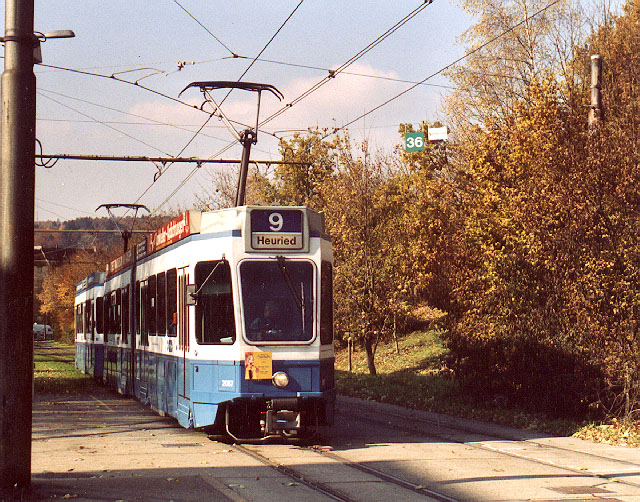 With the tram system secure once again, a new vehicle generation could be acquired. In 1976, the first Tram 2000 entered service. This clean angular design was well ahead of its time. Its interior is light and friendly and the floor surprisingly low for its age. The route indicator display on the front and rear of the vehicle is large and clearly visible, a feature that has been lost somewhat in the newer designer trams. Tram 2000 so convinced VBZ that it continued to buy this vehicle until 1992 with a total of 171 vehicles delivered.
With the tram system secure once again, a new vehicle generation could be acquired. In 1976, the first Tram 2000 entered service. This clean angular design was well ahead of its time. Its interior is light and friendly and the floor surprisingly low for its age. The route indicator display on the front and rear of the vehicle is large and clearly visible, a feature that has been lost somewhat in the newer designer trams. Tram 2000 so convinced VBZ that it continued to buy this vehicle until 1992 with a total of 171 vehicles delivered.
Besides the basic vehicle (2001-2121), a cabless version (2301-2315) was delivered for use in multiple with other units. There is also a shorter non-articulated cabless version (2401-2435, Pony) which allows the formation of an intermediate between a solo and a double Tram 2000 set. Thus, even more so than Mirages, Tram 2000's can be flexibly combined for practically any type of service [18]. As with the Standard Tram, the design attracted interest from other operators. Variants are now operated by RBS (Bern-Muri-Worb), Forchbahn (Zürich-Esslingen) and in Neuchâtel and Genova (Italy).
1976 also saw the extension of route 4 from Hardturm to Werdhölzli. This was the first tram extension since 1954 and had been recommended in the U-Bahn plans. The new section runs almost entirely on reserved track set in grass.
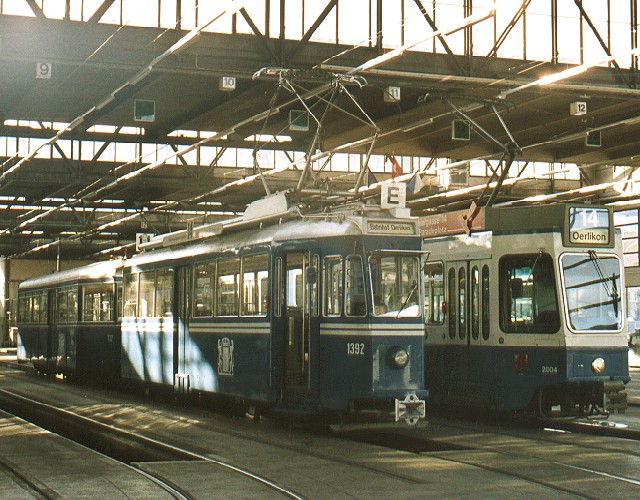 Despite these signs of renewed confidence in trams, the defeat of Tiefbahn and more especially U-Bahn had left a deep shock on planners and decision-makers. Zürich, so it seemed, had no blueprint or vision for its transport future. This vacuum was filled by the election of Ruedi Aeschbacher to the city executive council from 1978 to 1994. Aeschbacher profoundly believed that it was possible to plan for the future by making changes on a human scale rather than huge construction projects. More significantly, he believed in a non car-centric city. As the son of a railwayman, he recognised the potential of existing public transport in achieving this goal. Aeschbacher championed many of the tram priorities which users today take for granted (or no longer notice). He also pioneered traffic calming measures, putting pedestrians and public transport at the centre of his planning rather than cars. His ideas generated reactions of both disbelief and admiration from all over the world and many of his concepts have been copied in other cities.
Despite these signs of renewed confidence in trams, the defeat of Tiefbahn and more especially U-Bahn had left a deep shock on planners and decision-makers. Zürich, so it seemed, had no blueprint or vision for its transport future. This vacuum was filled by the election of Ruedi Aeschbacher to the city executive council from 1978 to 1994. Aeschbacher profoundly believed that it was possible to plan for the future by making changes on a human scale rather than huge construction projects. More significantly, he believed in a non car-centric city. As the son of a railwayman, he recognised the potential of existing public transport in achieving this goal. Aeschbacher championed many of the tram priorities which users today take for granted (or no longer notice). He also pioneered traffic calming measures, putting pedestrians and public transport at the centre of his planning rather than cars. His ideas generated reactions of both disbelief and admiration from all over the world and many of his concepts have been copied in other cities.
The Aeschbacher years saw a turning around of fortunes and attitudes. Whereas leaders had previously been ashamed of failing to deliver the Tiefbahn and U-Bahn and preferred not to mention transport at all, Zürich was achieving a model status with planners, politicians and journalists from all over the world flocking to Zürich to see what was being done.
However, in contrast to many other cities were trams had to go from being champions to outcasts and back to champions, they have always been popular and well patronised in Zürich. The priorities implemented were only achievable, both politically and financially, because the system was still largely intact and well used.
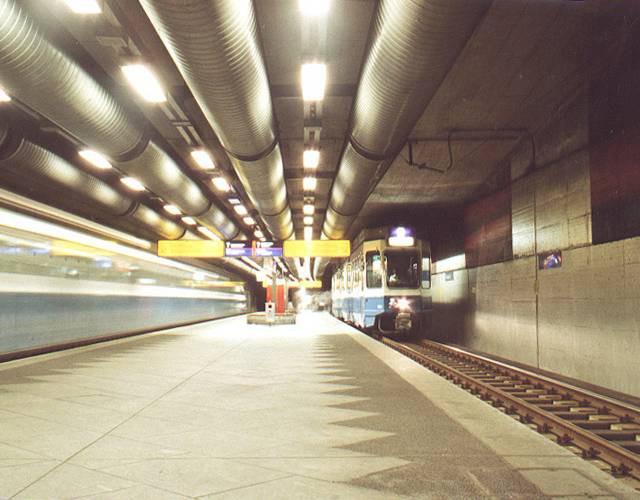 In 1986 the U-Bahn tunnel from Milchbuck to Schwamendingen finally found transport use when routes 7 and 9 were extended through it. In contrast to the U-Bahn line, which would have terminated at Schwamendingerplatz, the tram routes continue on surface beyond this and then fork giving Schwamendingen a network density comparable to that of older parts of the system.
In 1986 the U-Bahn tunnel from Milchbuck to Schwamendingen finally found transport use when routes 7 and 9 were extended through it. In contrast to the U-Bahn line, which would have terminated at Schwamendingerplatz, the tram routes continue on surface beyond this and then fork giving Schwamendingen a network density comparable to that of older parts of the system.
The subway section, on the other hand, gives passengers a taste of what they closely avoided getting a bigger portion of. The underground stops are reached through roundabout passages (imagine having to leave a subway stop by taking a stair down rather than up!), are dimly lit and often graffiti ridden. Hardly the friendliest way to entice more people to use public transport!
The subway has some points of technical interest. Left hand running applies because of the island platforms. As tunnel clearances were designed for third rail current collection, the fitting of overhead lines was not easy. Tram pantographs fold together to the maximum that safety margins allow, with low profile track-ties providing additional leeway.
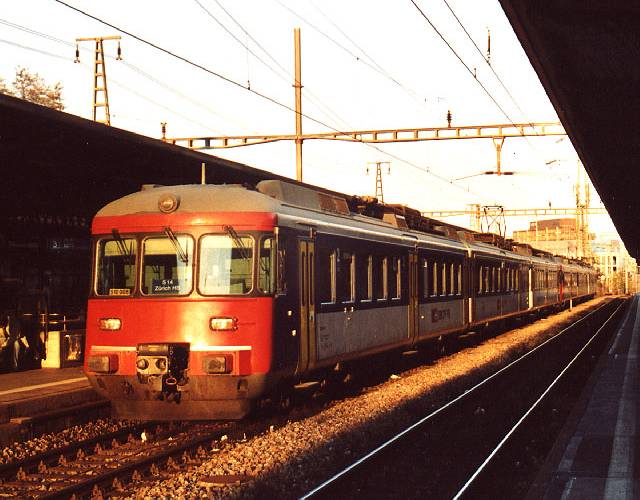 Whereas the VBZ tram network is entirely within the Municipal boundaries, most post-war residential development was in satellite towns where the city had little influence and where public transport was often less attractive. The resulting commuter flows caused additional congestion on Zürich's streets. A first park and ride scheme was introduced in 1960, but it became increasingly apparent that an isolationist approach to the problem could not deliver the desired results. To address the imbalance, the creation of a fast suburban rail or S-Bahn network was suggested in the Tiefbahn project and more explicitly so in the U-Bahn plans. In a third attempt to get this built, the S-Bahn was proposed independently of any such project. It was approved in a referendum in 1981 by 209'177 votes to 74'467.
Whereas the VBZ tram network is entirely within the Municipal boundaries, most post-war residential development was in satellite towns where the city had little influence and where public transport was often less attractive. The resulting commuter flows caused additional congestion on Zürich's streets. A first park and ride scheme was introduced in 1960, but it became increasingly apparent that an isolationist approach to the problem could not deliver the desired results. To address the imbalance, the creation of a fast suburban rail or S-Bahn network was suggested in the Tiefbahn project and more explicitly so in the U-Bahn plans. In a third attempt to get this built, the S-Bahn was proposed independently of any such project. It was approved in a referendum in 1981 by 209'177 votes to 74'467.
At the core of the S-Bahn is a new cross-city tunnel, which was completed in 1990. Elsewhere the S-Bahn relies on pre-existing railway lines, many of which have been upgraded and modernised. Thanks to the two-tier schedule with stopping and semi-express services on the principal corridors, journey times on many key connections are significantly faster than by road even at off peak times. The S-Bahn was an instant success and helped redress the balance in favour of public transport in the outer commuter belt. The S-Bahn's popularity has prompted a series of further investments with a second cross-city tunnel in the pipeline.
1990 was also the year that Zürich's integrated transport system (ZVV) [19] became reality. A zone based fare structure covering most of the S-Bahn area and integrating all forms of public transport was implemented. It often surprises visitors (and sometimes even locals) to learn that this includes lake steamers and the aerial cable car to Felsenegg. According to ZVV philosophy, integration must be total if it is to represent a credible alternative to the car.
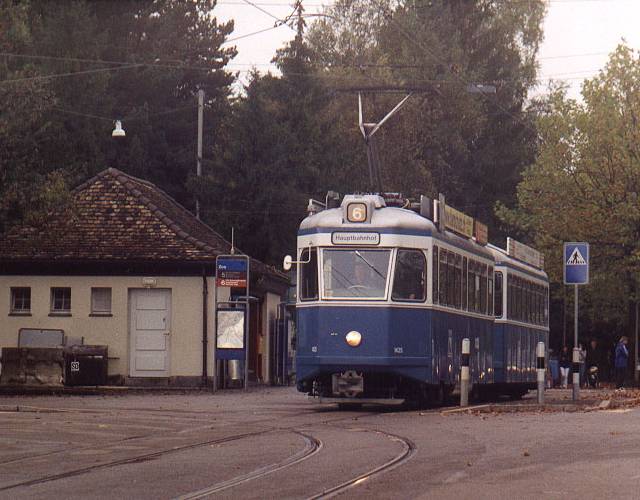 Sadly, even a successful system such as Zürich is not free of financial constraints. The growth of VBZ's operating deficit during the 1990ies (partly caused by fare sharing within ZVV) led to calls for economies. The possibility of pruning some of the more lightly patronised tram lines was considered, but in 1994 a general stretching of service frequencies (from 6 to 7 1/2 minutes) was chosen instead. Some cutting back of peak workings was also implemented. It was hoped that passengers would barely notice the longer waiting times and that congestion at junctions might be relieved at the same time (the latter did not occur). These cutbacks reduced the required fleet significantly and permitted the withdrawal of most of the remaining Standard Trams.
Sadly, even a successful system such as Zürich is not free of financial constraints. The growth of VBZ's operating deficit during the 1990ies (partly caused by fare sharing within ZVV) led to calls for economies. The possibility of pruning some of the more lightly patronised tram lines was considered, but in 1994 a general stretching of service frequencies (from 6 to 7 1/2 minutes) was chosen instead. Some cutting back of peak workings was also implemented. It was hoped that passengers would barely notice the longer waiting times and that congestion at junctions might be relieved at the same time (the latter did not occur). These cutbacks reduced the required fleet significantly and permitted the withdrawal of most of the remaining Standard Trams.
Readers should note that real headways are still significantly shorter than the official 7 1/2 minutes because several routes overlap on most corridors.
During the late 1980ies and early 1990ies, the next generation of Zürich trams started to take shape on the drawing board. A consortium of ABB, SIG and Schindler hoped to win an order when the time was ripe, and started work on the Cobra design. Short body sections and radially adjusting wheels were chosen to suit Zürich's tight curves. By hiding the necessary equipment under seats, a 100% low floor design could be achieved. The bodywork was to be made of wrapped polymer thread, which could be made stronger than metal but is more flexible in terms of design and variants through simpler tooling. This was to be a vehicle not just for Zürich, but also for other Swiss tram and light rail systems. Countless variants could be realised through the modularity of the design. The tram was also to be exported or offered under licence and a standard gauge and a diesel version were considered possible.
In 1990 the manufacturers acquired Bern tram 401, Muni [20]. This was rebuilt to incorporate many Cobra components (including a complete centre section) and was extensively tested in both Basel and Zürich. The experimental vehicle was named Munico, reflecting that it was a hybrid of Muni and Cobra.
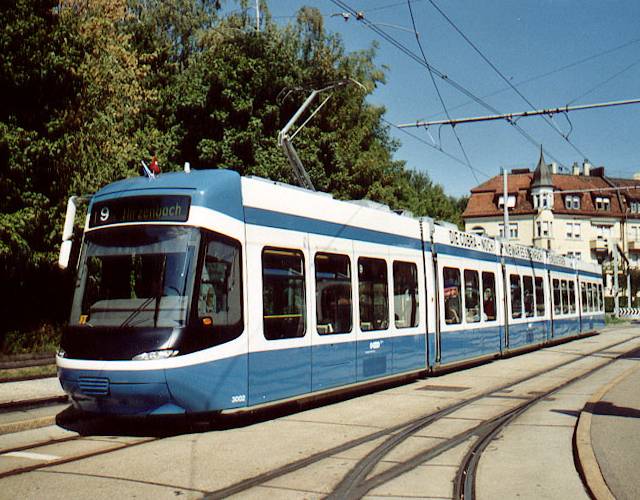 With the service cuts of 1994, it became clear that VBZ would not be ordering new vehicles soon, and the Cobra project lost momentum. In the following years, the rolling stock industry went through a major shake-up: In 1996, the transport division of ABB became part of Adtranz, and Fiat acquired a 60% stake in SIG's rail division. Adtranz acquired the rail division of Schindler in 1998, thus separating it from the polymer division. This led to Adtranz dropping the polymer innovations and opting for more conventional aluminium. Adtranz became part of Bombardier in 2000, with Fiat and SIG selling their railway interests to Alstom in the same year.
With the service cuts of 1994, it became clear that VBZ would not be ordering new vehicles soon, and the Cobra project lost momentum. In the following years, the rolling stock industry went through a major shake-up: In 1996, the transport division of ABB became part of Adtranz, and Fiat acquired a 60% stake in SIG's rail division. Adtranz acquired the rail division of Schindler in 1998, thus separating it from the polymer division. This led to Adtranz dropping the polymer innovations and opting for more conventional aluminium. Adtranz became part of Bombardier in 2000, with Fiat and SIG selling their railway interests to Alstom in the same year.
Whereas Cobra had once been the pride and hope of its developers, it was now a product among many others in the portfolios of the ever-changing owners. Munico had been demonstrated in Helsinki (1995) and Augsburg (1996) but no further such promotion followed the take-over turmoil. At one point it was even questioned whether the design should survive at all. But having a foot in the door for a Zürich order motivated the manufacturers to continue developing Cobra, despite being able to offer other designs. In analogy to the Mirage story more than 30 years previously, Cobra was to take another knock when Basel took preference to Siemens' Combino in 1999 leaving Zürich as only interested candidate. At present it seems unlikely that any Cobras will be sold outside Zürich.
After an evaluation of alternative designs, VBZ took delivery of a pilot batch of 6 Cobras (3001-3006) in 2001. The new trams are externally styled by the Italian sports-car designer Pininfarina. The interior is by the local design office, e-team, and based on concepts tested by Zürich's design school in an experimental rebuild of Mirages 1690 and 1691. After the age of plastics of Tram 2000, there is a return to wood and metal in the interior finish. A large surface of glass separates the cab from the passenger compartment, improving security and allowing better viewing for passengers. The interior illumination is based on soft indirect lights. To facilitate reading, halogen spots are additionally mounted above the seats.
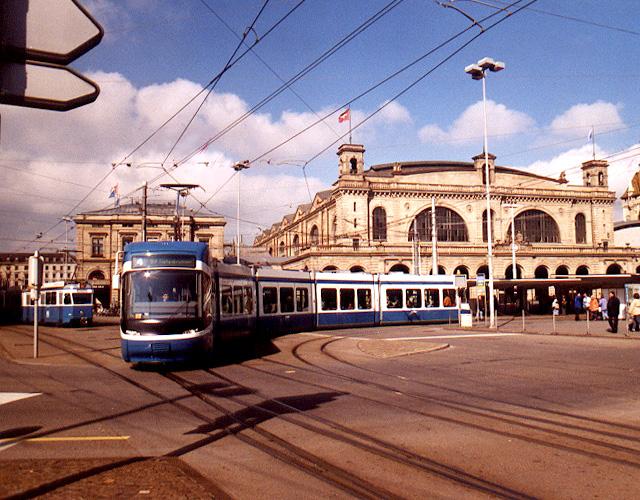 The question of why Zürich is buying a custom vehicle when so many off the shelf designs are available has often been raised. When Cobra was first imagined, the design was well ahead of its time and no obvious competitor could be identified. Through the delays and changes in the realisation process, this advantage has become less clear. However, VBZ still consider Cobra good value for money and fitting for a city which prides itself on quality transport.
The question of why Zürich is buying a custom vehicle when so many off the shelf designs are available has often been raised. When Cobra was first imagined, the design was well ahead of its time and no obvious competitor could be identified. Through the delays and changes in the realisation process, this advantage has become less clear. However, VBZ still consider Cobra good value for money and fitting for a city which prides itself on quality transport.
The design was initially plagued by problems ranging from excessive noise and vibrations to reliability of doors and gearboxes. When these issues had been resolved, VBZ placed an order for 68 similar units (3007-3074). These will be delivered from late 2005.
Zürich's Cobras are 5 section units with a length of 36m, which is similar to a Tram 2000 + Pony formation. VBZ hopes the additional width (2.40m instead of 2.20m) will make the Cobras capable of replacing a coupled Mirage set (41.8m). Whether this will work in practice remains to be seen. Until now the Cobras have only been used on routes otherwise served by Tram 2000 + Pony (36.8m) or Mirage + bogie trailer (34.7m) formations.
It may come as a surprise, that despite the much-praised modularity of the Cobra design, no shorter or longer variants have been ordered. According to VBZ, a 7-section unit (48m) would be too long for many stops. Loading platforms cannot always be easily extended because track layout and external constraints at many junctions do not allow this. It remains to be seen whether this policy will be adhered to in the long term or whether a way can be found of accomodating such trams. There are sufficient Tram 2000's available to cover the routes with lighter loadings and so shorter Cobras are equally unlikely in the foreseeable future.
<previous chapter | table of contents | next chapter>
Zürich tram main page | articles list
Footnotes:
[18] Until the mid 1990ies it was common practice for Mirage and Tram 2000 coupled set formations to be shortened for late evening service.
[19] ZVV (Zürcher Verkehrsverbund).
[20] Muni was a development of the Mirage design delivered to Bern as a prototype in 1966. Muni featured radially adjusting wheelsets not too different from those of Cobra.
<previous footnotes |
footnotes continued>
last updated: 14.12.05
counter added: 14.12.05